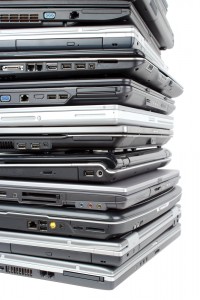How Should Businesses Handle Planned Obsolescence and Electronic Waste?
 The holidays are here; and with them sales galore on all sorts of devices and gadgets. While this may be a less expensive time of year to replace your business’s electronics, doing so may incur greater costs than the one coming out of your wallet. In the spirit of technological upgrades and all things faster and better, ‘tis the season to talk about planned obsolescence and electronic waste, and the effects they can have on your business!
The holidays are here; and with them sales galore on all sorts of devices and gadgets. While this may be a less expensive time of year to replace your business’s electronics, doing so may incur greater costs than the one coming out of your wallet. In the spirit of technological upgrades and all things faster and better, ‘tis the season to talk about planned obsolescence and electronic waste, and the effects they can have on your business!
Planned Obsolescence
Whether or not you’re familiar with the term, you have undoubtedly fallen prey to planned obsolescence at one time or another. That notification on your computer or mobile device alerting you to an update waiting to be installed, which you ignore because you know it will be the equivalent of injecting molasses into your motherboard. The uncanny way electronics seem to know when their warrantees expire, so they can self-destruct mere moments after. The newest model of smartphones and tablets being released every year; rendering the one you bought a few weeks ago more obsolete by the minute. No, these phenomena are not all in your head; on the contrary, they’re quite intentional.
Investopedia defines ‘planned obsolescence’ as:
“A manufacturing decision by a company to make consumer products in such a way that they become out-of-date or useless within a known time period. The main goal of this type of production is to ensure that consumers will have to buy the product multiple times, rather than only once. This naturally stimulates demand for an industry’s products because consumers have to keep coming back again and again.”
Planned obsolescence can take a variety of forms, from batteries that can’t be replaced to software updates that are incompatible with older hardware to product design that makes future repairs nearly impossible. According to collaborative economy expert Rachel Botsman in a recent Guardian article, the reason “consumers haven’t stood up and said the planned obsolescence of the gadget industry is absolutely obscene and not serving them” is because “no one has yet cracked a subscription model to electronics that takes the responsibility away from the consumer and puts it on the company to provide better products.” (Although this doesn’t necessarily improve the quality of products, it is important to note that Canada and Europe do put some responsibility back on the companies by widely using Extended Producer Responsibility (EPR) laws that require manufacturers to fund and manage the disposal of goods they produce. It’s also important to note that there are no federal EPR laws in the U.S.; only a patchwork of state laws that make manufacturer compliance challenging.)
Electronic Waste
With planned obsolescence inevitably comes a collection of outdated, unusable electronics that have to be disposed of in some way. According to the most recent data from the Environmental Protection Agency (EPA), 3,140,000 tons of electronic waste was generated in the U.S. in 2013. Of this volume, only 40.4% was recycled; which may be in large part due to the 16 states that have banned some or all forms of electronic waste from entering landfills and/or incinerators. (Here’s a handy chart that shows the fluctuations in e-waste generation and recycling from 2000-2013…but be sure to read the fine print, so you don’t get too excited about the “progress” made between 2012 and 2013.)
If you’re not entirely sure why it’s important to keep your business’s electronic waste out of landfills, try these stats on for size:
- “If Americans recycled the more than 100 million cell phones that are no longer used, the amount of energy saved would be enough to power approximately 24,000 U.S. households for approximately one year.” (NRDC)
- “Recycling one million laptops saves the energy equivalent to the electricity used by more than 3,500 U.S. homes in one year.” (EPA)
- “For every million cell phones we recycle, 35,000 pounds of copper, 772 pounds of silver, 75 pounds of gold and 33 pounds of palladium can be recovered [saving the energy required to mine new metals].” (EPA)
- Many electronics contain mercury, lead, and cadmium; heavy metals that are toxic to humans and linked to cancer, neurological damage, reproductive issues, and more. These chemicals (along with flame retardants, plastics, chromium, and other persistent chemicals) are released into the air and water when electronics are deposited in landfills or burned in incinerators.
Throwing away electronics can pollute air and water sources, leading to a whole slew of serious health problems. Nearly 2 million tons of electronic waste are added to landfills every year. Making new electronics releases a significant amount of greenhouse gases; from mining for materials to manufacturing products to getting the gadgets in your hot little hands. So yeah, electronic waste is pretty bad for the environment.
So what’s a technology-dependent business to do?
Although electronics companies maintain a relentless grip on our tech-dependent society, you don’t have to give in to planned obsolescence – you can hold onto your devices as long as humanly possible, and you can even use your consumer spending power to demand longer-lasting products. Other options include having your electronics repaired rather than tossing them (I know, I know – mind-blowing concept), or learning how to easily fix them yourself.
However, when the time comes to wave your white flag in surrender, there are ways to upgrade your electronics responsibly and without poisoning the planet:
- Selling or giving away used electronics is a great way to keep them out of landfills (while also giving you some extra cash or a tax write-off). There are many organizations you can donate them to that will give them to schools and nonprofits in need…and this can also be a great idea for a charitable giving program.
- When buying new devices, check to see if the retailer has a program for buying back your old ones to be refurbished. Along similar lines, instead of buying new devices for your business, get refurbished ones!
- Every state has places where you can bring your electronics to be recycled. However, it’s very important to only donate to certified e-Stewards Recyclers; to ensure your electronic waste is being recycled properly, safely, and in the most globally-responsible way…and is not being shipped overseas to developing nations. (Note: all Staples stores are drop-off sites for e-Stewards Recyclers.) There is another certification program for electronic recycling called Responsible Recycling (R2), and you can see how it stacks up to e-Stewards in a side-by-side comparison.
So when the device you’re reading this article on gasps its last dying breath, give one of those suggestions a try. And if all else fails, you can always turn your electronic waste into art and other cool stuff.
 © 2024 Manomet. All rights reserved.
© 2024 Manomet. All rights reserved.

 Lora Babb is the Director of the
Lora Babb is the Director of the 
